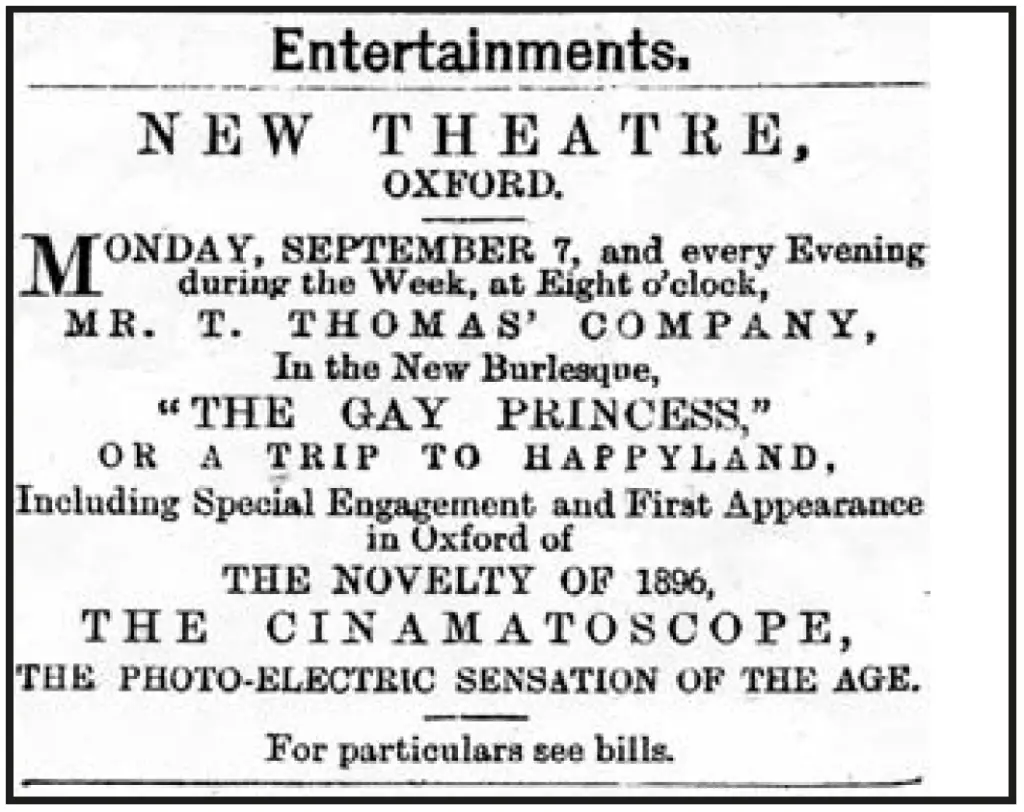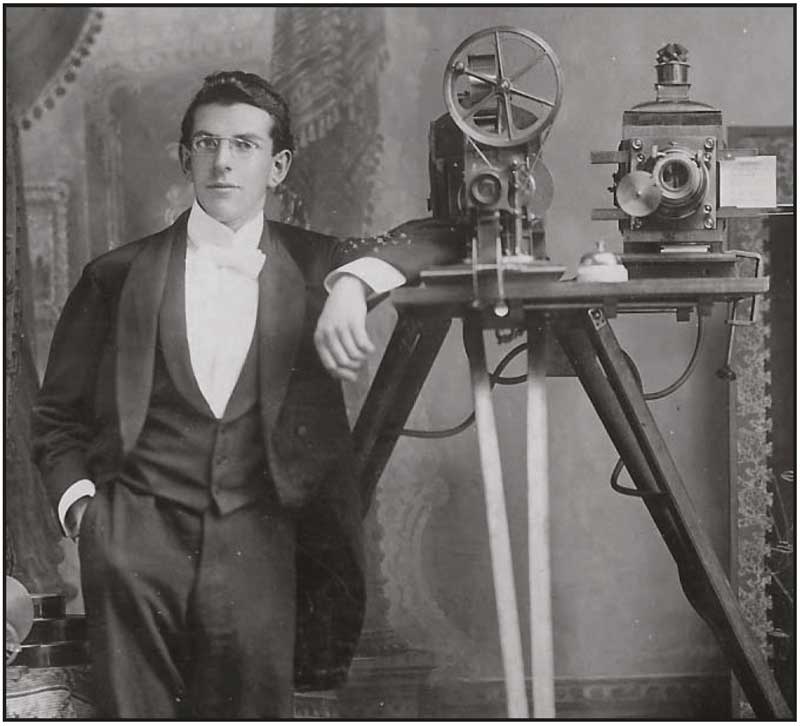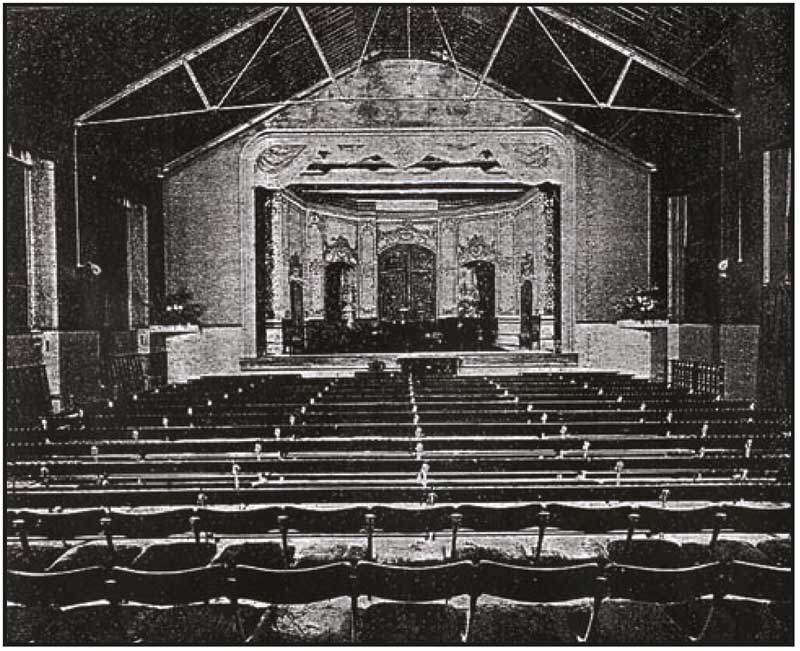The Photo-Electric Sensation of the Age (part one of The Ultimate Survivor tell the story of the picture palaces from their beginnings as mere fairground sideshows, to the era of “Picture Palaces” such was that which opened in East Oxford in 1911. Excerpt from the accompanying booklet The Ultimate Survivor by Ian Meyrick.
Projected moving pictures were first seen by the British public when two French brothers, Louis and August Lumiere, presented their Cinématographe to an invited audience at the Regent Street Polytechnic in London. The date was 20 February 1896 – fifteen years later, almost to the day, the Picture Palace in Jeune Street would open its doors.
The new medium was a hit from the start; for the price of a few pennies the audience could see a selection of short ‘subjects’ which included a train drawing into a country station, the fall of a wall, a baby being fed by proud parents and workers leaving the Lumiere factory. All lasted less than a minute and were just as they were described – animated photographs; the wonder came from the fact that they actually moved. Even these early shows, however, had one film that contained a little story. The Gardener or The Sprinkler Sprinkled shows a mischievous boy stepping on the hose to stop the flow of water and then removing his foot when the gardener looks down the nozzle to see why the water has stopped. Slapstick chase comedy has been with us from the very start.
The Lumiere Cinématographe soon transferred to the nearby Empire Music Hall in Leicester Square. Other similar shows by rival inventors and exhibitors sprang up, principally that of Robert Paul at the Alhambra, which was later destined to be the site of the famous Odeon Leicester Square.
The spread of the new novelty under various names throughout the country was remarkably rapid. On 7 September, less than seven months after that first showing in London, theatre-goers in Oxford had the opportunity to see a new burlesque show at the New Theatre in George Street, The Gay Princess, which included the first appearance of ‘the novelty of 1896, the Cinamatoscope’.
The Oxford Times correspondent was greatly impressed, describing it as one of the smartest vacation shows seen in Oxford for a long time. There was apparently ‘no plot to speak of, the title adequately expressing the idea the development of which affords nearly three hours’ genuine amusement’. Light, colour and movement were in abundance with ‘clever dancing and several catchy songs’. Mr Albert Johnstone played the bagpipes and a good time was obviously had by all concerned.
The particularly exciting thing for the audience, however, was the first chance to see moving pictures thanks to the Cinamatoscope, although how it fitted into the whole show is not explained:
On a sheet on the darkened stage is thrown by means of lime-light realistic lifelike representations of a racecourse; persons diving into the water and swimming, in which the spray thrown up by their contact with the water is seen in motion; the evolutions [sic] of a skirt dancer; a dance by two girls under an umbrella; and a number of other incidents, in all of which the actual movements of the persons or animals are shown reproduced.

At this stage, moving pictures were seen as a novelty with only a limited life expectancy. They could be used as a ‘turn’ in music hall programmes and were also a popular attraction at fairs including St Giles’ Fair in Oxford, where showmen such as William Taylor, ‘Professor’ Alf Ball and Charles Thurston gathered in the crowds with ever more elaborate show fronts, decorated with electric lights.
A significant event for Oxford cinema took place on 1 January 1900 when H. Albany Ward took over as licensee of the East Oxford Constitutional Hall in Cowley Road, which was operating at the time as the Lyric Hall. He renamed it The Empire Theatre of Varieties and set about presenting music hall shows with regular animated pictures as part of the programme. This theatre was to become closely connected with the future Jeune Street Picture Palace’s own history.
Albany Ward (his real name was Hannam Edward Bonnor) proudly described himself in later life as one of the original picture pioneers. He had every right to that claim, having met and worked with Birt Acres (an associate of Robert Paul) when a teenager in Ilfracombe. He had then worked for the Velograph Company, travelling the country with their film of Queen Victoria’s Jubilee procession, to great success.

He had clearly decided to settle down, and ran the theatre in Cowley Road, virtually opposite Jeune Street, from 1900 to 1906. As well as the theatre, he ran an entertainment booking agency and a billposting company from his office and flat above the entrance.
In 1906 he unsuccessfully applied to the City Justices to give two cinematograph shows lasting around an hour, giving assurances that all the insurance requirements would be met. No reason was given for the refusal and he forwarded the correspondence to the trade paper The Era, which was scathing in its comment:
These cinematograph exhibitions are allowed in every music hall and theatre in the United Kingdom; yet these high and mighty Justices refuse permission to Mr. Ward to give one of them.
The Era
Not for the last time was the cinema business to cross swords with those in authority locally. Albany Ward left Oxford the same year to run the Palace Cinema in Weymouth and built up a sizeable circuit in the West Country, which eventually became part of the Gaumont chain; he also ran a large advertising and poster printing business.
Under his management, the Empire had been the first building in Oxford showing films as part of its programmes on a regular basis, and this continued under his successor at the theatre, Frank Stuart.

The booklet by Ian Meyrick which accompanies the documentary can be purchased from the Cinema Theatre Association.
Contact us for further details